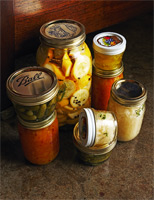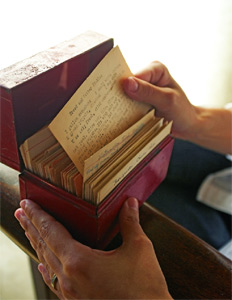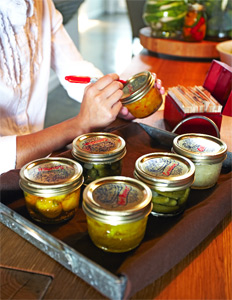In Season
Hazel Mosier leads the way down the narrow steps to the basement of her East Tennessee home. It is early autumn, 1999; the year the world might end. While the rest of us were taking advice from Prince and “partying like it was…”, Hazel was working. Her basement walls were lined with what at first glance looked like a modern art installation—a work in concrete, wood and colored glass. Closer inspection revealed cinderblock walls, wood shelves and hundreds of jars holding summer’s bounty.
Beans, okra, peaches and tomatoes put up at the peak of their flavor. Berries were turned into preserves and apples into her famous apple butter. The scene was marvelous—sweet and Southern. At that point, Hazel turned around with a sweep of her arm and a gimlet eye and said, “I’m ready for Y2K.”
Well, 2000 came and went, and while not many of us have ever had to worry about making it through a winter with enough food, a lesson was taught to us that day in the basement. Mrs. Mosier died a few years later, but the cookbooks and small kitchen file that remained left us our assignments. Written in her own hand, or typed out with handwritten notes in the margins, are Hazel’s instructions on how to create her delicacies. Pickles and relishes seemed to be a big deal, and because there are so many written suggestions on what to add or how to replace one ingredient with another, it is revealed that pickles are something that any cook can make his or her own. Johnny’s Zucchini Relish, Shelby’s Watermelon Rind Pickles, Amanda’s Bread and Butter Pickles—get it? The tweak of a recipe allows a cook to claim ownership.
Historically, pickling was a form of food preservation. Soaking something in brine or vinegar allowed food to be stored, without refrigeration, for a long time. Bumper crops were canned and pickled, ensuring that even the most humble dining table was laden with healthy vegetables all winter long. Pickles made from cucumbers, okra, green tomatoes and even peaches and watermelon rinds always added a tangy flair to the plate. Relishes such as “chow chow,” made from cabbage, green tomatoes, peppers and spices, and artichoke relish, made from Jerusalem artichokes or “Sunchokes,” are downright exotic.
Southerners developed a multifaceted palate early on by celebrating the balance of vinegar and sugar, salt and spice. The type of vinegar (white or apple cider), the size of the salt grains, or perhaps plopping a hot pepper into each jar-all play a role in the recipe. This playing around with flavor and technique, whether mandated by the restrictions of poverty or for pure adventure, is what makes the evolution of cuisine interesting and delicious. Opening a container of pickles or relish made from a family recipe is history in a jar.
Atlanta has become a food town. We have great chefs and eat out often. Slk bars call us to drink civilized, “classic” cocktails. And our bartenders are paying close attention to the details that make an outstanding, signature drink. While sitting in the midst of those sophisticated structures, look hard. Next to a sleek bottle of gin there may be a Mason jar filled with house-made pickled onions. Eye-dropper bottles filled with chef-stirred tinctures are there, waiting to be married with the finest small-batch Southern rye. Sophisticated bars and dives alike are adding pickled okra and “tomolives” (pickled, green cherry tomatoes) to the skewer that gets dunked into that Bloody Mary. Besides, all those Southern vegetables turn that tomato juice cocktail into lunch, right?
Those same chefs are playing with tastes inspired by the classic “meat-and-three plate” or the spread from a “covered dish dinner on the grounds.” Rarely is a church social spread without a relish tray, or two or three. No matter how full the plate gets as one moves down that table, there is always room for a spoonful of chow chow and a couple of slices of bread and butter pickles on top. While the pickles may be an afterthought, they turn into a surprisingly delicious blend of flavors as that juice penetrates everything else on the plate. Great chefs pay attention to those surprises and are now adding bread and butter pickles to their $30 entrées. Fried dill chips may show up as an “amuse bouche.” Perhaps a “mad scientist” chef will stir liquid nitrogen into the cornichon juice to sit on top of liver pate. However those pickles show up—as the sauerkraut on a deli sandwich or in your $15 cocktail—give a nod to the effort and thought put into the process.
Angie Mosier on Pickling
In addition to writing, I spend many of my days working as a food stylist. That means I make food look good for photography, film and sometimes live television. Every once in a while, I shop and prepare food for the television appearance of a celebrity chef passing through Atlanta.
Recently, I spent the day with a woman who hosts a cooking show that focuses on food that can be prepared quickly.
She asked me what I saw as an upcoming food trend. “Pickling,” I replied. “I think there will be a return to pickling and preserving.” She retorted, “There is no way people are going to take up pickling again.” Her argument: folks barely take time to put something in the microwave—much less sterilize jars, then chop, soak and seal up vegetables.
Now, I understand that there are lots of busy people who have to juggle schedules and dinner times, but there are lots of us who do care about cooking and making the most of what we have. In fact, I would like to see pickling and preserving added to the list of what is considered sustainable living. Pickling is an example of taking strides to reduce our carbon footprint, and the American South is still growing some of the best produce on the planet, so the practice of putting up vegetables makes total sense.
Plus, it’s fun. Kids love helping out, you get some quality family time, not to mention a science project (learn how the heat seals the jars and lids, ensuring the safety of the food), and a history lesson (explain why your grandmother, or folks in general ended up pickling). So take a Saturday afternoon and put up some pickles!
Angie’s easy pickling tips:
• Buy canning jars at the grocery store or at your neighborhood hardware store. (Ace Hardware carries all kinds of good canning supplies.)
• Sterilize jars and lids, with their sealing rings, by placing them in a stockpot filled with cold water and brought to boil for 10 minutes. Jars can then be placed on a tray and held in a 200-degree oven until ready to be filled.
• Follow your favorite pickle recipe, but don’t be afraid to add a dash of this or that to make it your own.
• Fill the jars, seal them with the lids and rings, then start listening for the telltale popping of the lids sealing as they cool.
• Give the pickles as gifts or stock up for the winter.










